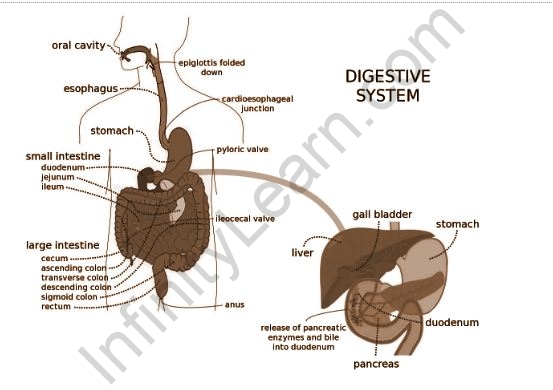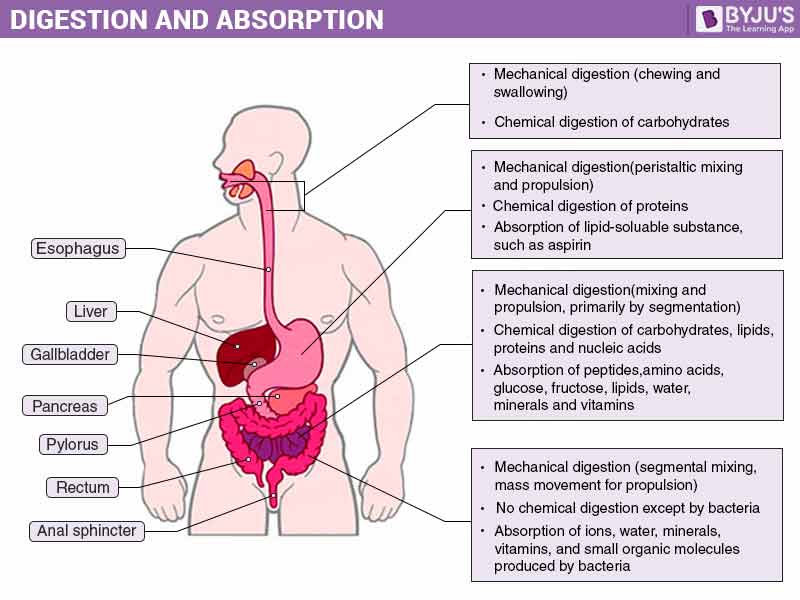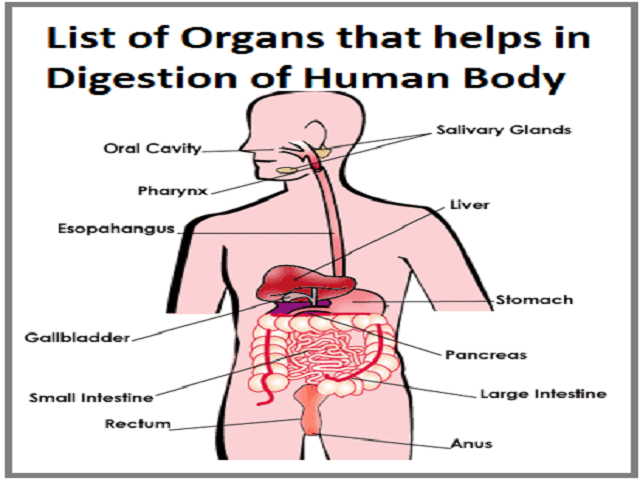The Body Absorbs Which Form of Digested Carbohydrates
See full answer below. The most common dietary lipids are triglycerides which are made up of a glycerol molecule bound to three fatty acid chains.

Bloated 6 Foods To Shrink Your Belly Fastmetabolism Food Healthy Healthy Living
1 Simple diffusion 2 Active transport and 3 Facilitated transport.

. There are three main types of carbohydrates. They are then passed into the bloodstream and towards the liver. Digestion begins from the mouth itself not.
Starches and sugars are considered the energy-yielding carbohydrates because they are fully digestible and once absorbed they provide the body with 4 calories of energy per gram of carbohydrate. It leads to the breakdown of complex disaccharides form of carbohydrate into simple monosaccharide form of carbohydrate for absorption. 11 rows Once absorbed carbohydrates pass through the liver glucose is the main form of carbohydrate.
Chewing also known as mastication crumbles the carbohydrate foods into smaller and smaller pieces. Digestion is a form of catabolism or breaking down of substances that involves two separate processes. Digesting or metabolizing carbohydrates breaks foods down into sugars which are also called saccharides.
Fructose is absorbed by the facilitated diffusion which slows down its entry and produces a smaller rise in blood sugar. The main source of carbohydrates in the human diet is polysaccharides mostly in the form of starch. 4 - Large Intestine or Colon.
Digestion and Absorption of Carbohydrates From the Mouth to the Stomach. Carbohydrates are only absorbed in their b. Digestion of carbohydrates by the body When we eat foods that contain carbohydrates the body needs to break these down into simple monosaccharides for the body to use.
They are absorbed by intestinal villi which are glycerol and short-chain fatty acids. Some of the sugars are converted into glucose before absorption. Among carbohydrates only the monosaccharide forms are absorbed.
The monosaccharides are absorbed in the small intestine by three mechanisms. Insulin increases the number of glucose transporters on the cell membrane to allow the transport of glucose into the cell. 4 Large Intestine or Colon.
Mechanical digestion and chemical digestion18 sept. Pancreatic amylase further breaks down the. Which of the follow statements regarding glucose absorption is true-Glucose is absorbed mostly in the stomach-Glucose is absorbed mostly through the lining of the small intestine-Glucose is digested in the small intestine-Glucose is absorbed solely through the.
The mechanical and chemical digestion of carbohydrates begins in the mouth. Carbohydrates The chemical digestion of carbohydrates begins in the mouth. Some monosaccharides are absorbed via a form of passive transport namely facilitated diffusion.
After digestion carbohydrates are absorbed in the small intestine with the help of minute finger-shaped projections known as Villi. The digested carbohydrates now in the form of glucose are ready to be absorbed by the body. Blood glucose levels rise following the digestion of a carbohydrate-rich meal.
Any carbohydrates that werent digested in the small intestine -- mainly fiber -- pass into the large intestine but theres no enzymatic digestion of these carbohydrates here. A number of factors affect carbohydrate digestion and absorption such as the food matrix and other foods eaten at the same time 7. Once a protein source reaches your stomach hydrochloric acid and enzymes called proteases break it down into smaller chains of amino acids.
Similarly where is carbohydrate digestion completed. Alternatively fiber is a type of carbohydrate which is not fully digestible because. Digestion of carbohydrates.
Absorption of Carbohydrates Glucose fructose and galactose are absorbed across the membrane of the small intestine and transported to the liver where they are either used by the liver or further distributed to the rest of the body 3 4. The cells of small intestine can only absorb simple sugars and thats why they absorb glucose fructose and galactose. The end products of carbohydrate digestion are glucose fructose galactose mannose ribose etc.
Which of the following statements regarding absorption of monosaccharides is true. Carbohydrates give the body energy to go about your days mental and physical tasks. Starches sugars and dietary fiber.
The salivary glands in the oral cavity secrete saliva that coats the food particles. Dietary carbohydrates are digested to glucose fructose andor galactose and absorbed into the blood in the small intestine. Hence all carbohydrates must be digested to glucose galactose and fructose for absorption to proceed.
Insulin is secreted from the beta cells of the pancreas into the bloodstream. Carbohydrate digestion occurs in different parts of the body. The glucose molecules are small enough to pass through the epithelial cells in the small intestines.
In the same way starch is broken down with the help of the Amylase enzymes which are present in the mouth and the stomach. Any carbohydrates that werent digested in the small intestinemainly fiberpass into the large intestine but theres no enzymatic digestion of these carbohydrates here. Glucose and galactose enter the cell through active transport.
The digestion process of polysaccharides such as starch will begin in the mouth where it is broken down or hydrolysed by salivary amylase an enzyme in your saliva that helps to break down starches. Insulin stimulates glyucogenesis in the muscle cells a insulin stimulates the liver to store excess. Once absorbed carbohydrates pass through the liver glucose is the main form of carbohydrate circulating in the bloodstream.
Acute metabolic fate of fructose in the body within 6 hours of ingesting 50-150 grams about 12-36 teaspoons of fructose adapted from Sun et al 2012 Factors that Affect Absorption of Carbohydrates. Humans must metabolise carbohydrates to use them as energy. In the Large Intestine Colon The carbohydrates that are not digested and absorbed by the small intestine then go to the colon where they are then broken down by the intestinal bacteria.
A-Amylases salivary and pancreatic hydrolyze 14-glycosidic bonds in starch yielding maltose maltotriose and α-limit dextrins. Glucose is absorbed mostly through the lining of the small intestine. The body absorbs glucose which is converted from complex starches into monosaccharides.
Once absorbed carbohydrates pass through the liver glucose is the main form of carbohydrate circulating in the bloodstream. Carbohydrates begin to be digested in the mouth by salivary amylases. Which of the following are involved in lipid digestion.
Monosaccharides are the carbohydrates that are the smallest monomers within the. 2020 How proteins are digested in our body.

Question Video Identifying The Component Of Food That Is Absorbed Into Blood Without Being Digested Nagwa

Digestion And Absorption Of Carbohydrates Proteins And Lipids

Digestion And Human Health So Where Does All That Food Go Ppt Download

Digestion And Absorption Infinity Learn

Absorption Of Digested Food By The Human Body An Overview

Lesson Video Absorption And Defecation Nagwa

Small Intestine Histology Digestive System Anatomy Human Body Anatomy Tissue Biology
Where In The Body Are Carbohydrates Broken Down Quora
Where Does The Digestion Of Carbohydrates Begin What Is The Process Quora
Digestion And Absorption Of Carbohydrates Human Nutrition Deprecated

Pin By Christine Rebecca On Anatomy Physiology Nursing School Notes Medical Medical Education

25 3 Digestive System Processes Texas Gateway

Carbohydrate Digestion And Absorption Carbohydrate Metabolism Youtube

Chapter 4 Carbohydrates Sugar Starches And Fiber Carbohydrate

Digestion And Absorption Of Carbohydrates Proteins And Fats



Comments
Post a Comment